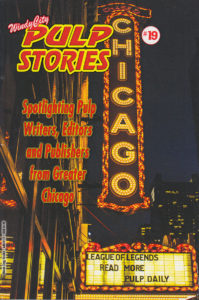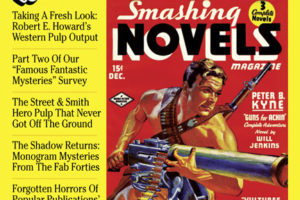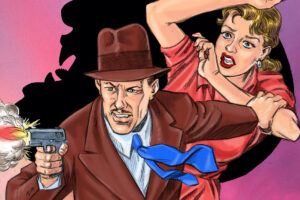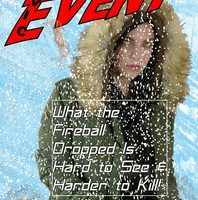 It’s 2019, this year’s Windy City Pulp and Paper Convention has come and gone, but the 2019 program book, the new Windy City Pulp Stories #19, is still here. Sadly, due to issues with Amazon’s CreateSpace, it is not as easily available as in the past. I really hope Black Dog Books, and people will be able to order it with the past books.
It’s 2019, this year’s Windy City Pulp and Paper Convention has come and gone, but the 2019 program book, the new Windy City Pulp Stories #19, is still here. Sadly, due to issues with Amazon’s CreateSpace, it is not as easily available as in the past. I really hope Black Dog Books, and people will be able to order it with the past books.
I was able to obtain a copy, and here is my review of it. This year the focus is on the pulp writers, editors, and publishers from the Chicago area. While New York was a major publishing center, several pulps originated in Chicago — most notable is Weird Tales. But also in Chicago were the publisher behind Red Book, Green Book, and Blue Book and the small publishers producing 10 Story Book and Real Detective Tales. The issue also includes a short photo section with sample covers from these pulps.
Also in this issue, we look at H. Bedford-Jones, J.C. Henneberger, Edwin Baird, Farnsworth Wright, Vincent Starrett, Merlin Moore Taylor, Harry Stephen Keeler, MacKinlay Kantor, and Frank Robinson. We get information about this people, then usually a sample of their writing. So what do we get?
H. Bedford-Jones (1887-1949) was the “King of the Pulps,” who wrote some 200 novels and a lot of short stories in all the major pulps. Tom Roberts gives us a brief overview of his life and career, which began in Chicago. Along with this is a short article on the author at 21 that was published back in 1926, and a 1912 story, “A Crust of Bread.”
J.C. Henneberger was the founder of Weird Tales, who sadly stepped out of the picture after he sold ownership of the pulp to his printer. We get a short article on him by Sam Moskowitz from 1970.
Edwin Baird (1886-1954) was the first editor of Weird Tales, as well as the editor of Real Detective Tales, which was another pulp published by Rural Publications. When Henneberger ran into problems, Real Detective Tales was sold off and continued to be published into the 1930s under Baird’s editorship. MacKinlay Kantor provides an article on him from Author & Journalist in 1929. Then we have a letter from Kantor to researcher Peter Ruber, with more info on Baird. A crime story, “The Red Shell” from Wayside Tales in 1922 rounds out this section.
Farnsworth Wright (1888-1940) was the long-time editor of Weird Tales. An article on him by Jules Schwarz that appeared in Science Fiction Digest in 1933 is accompanied by a story of his, “An Adventure in the Fourth Dimension,” from Weird Tales of 1923, a poem, and a crime tale from Overland Monthly of 1920.
Vincent Starrett (1886-1974) was a well-known writer, editor, and bibliophile. He was a Sherlock Holmes fan, but also wrote for Weird Tales and detective tales. We get an article on him, his early Holmes pastiche “The Unique Hamlet,” and a sample of his verse.
Merlin Moore Taylor (1886-1939) was a writer and editor. He worked for W.D. Boyce on his weekly papers, but also wrote fiction. We get an article on him and a sample of his fiction, “The Wicked Flea,” from The Chicago Tribune in 1922.
Harry Stephen Keeler (1890-1967) was another writer and editor. He was notable for writing epic two-part mystery novels with convolution storylines referred to as “webworks,” before moving to stand-alone novels. He also worked as an editor, and assisted Merlin Taylor at Boyce’s publications and Ten Story Book. He was the fiction editor for them. In addition to an article on him, we get two of his works, “The Search” and “Thirty Seconds of Darkness,” both from Ten Story Book. Ramble House has brought back his works in print, for those interested.
MacKinlay Kantor (1904-77) was a journalist, novelist, and screenwriter who won the Pulitzer Prize. He started in the pulps and was able to move to the “slicks,” something not every pulp author was able to do. We have an article on him with along with “The Ten-Thousand-Dollar Bag” from Real Detective Tales from 1928.
Frank Robinson (1926-2014) was an editor as well as science fiction and techno-thriller author. He also became a pulp collector, which lead to writing Pulp Culture (1998), Science Fiction of the Twentieth Century (1999), Art of Imagination (2002), and The Incredible Pulps (2006). In addition to an article on him, we get “The Day the World Ended” from Beyond Science Fiction in 1953.
It’s another great volume. I do hope they fix the problem with making this available to others, and that they fix some of the printing errors I found in my copy, which are probably in the print file.



